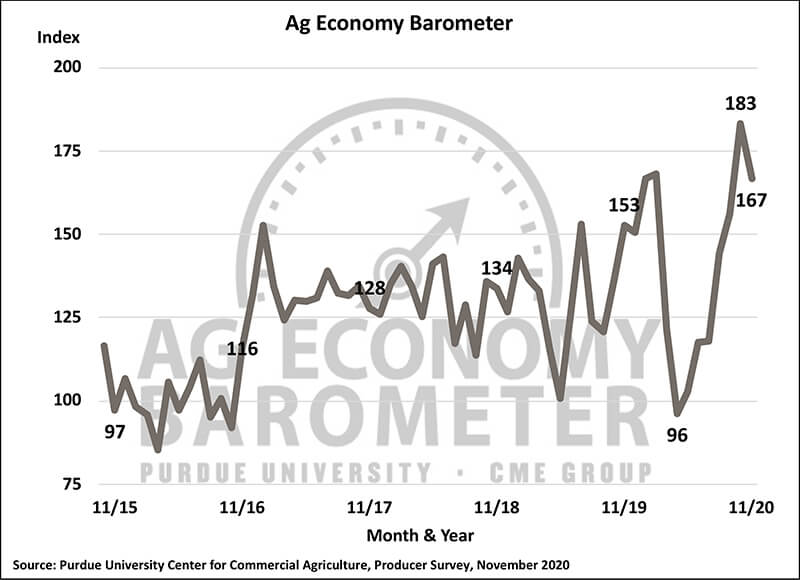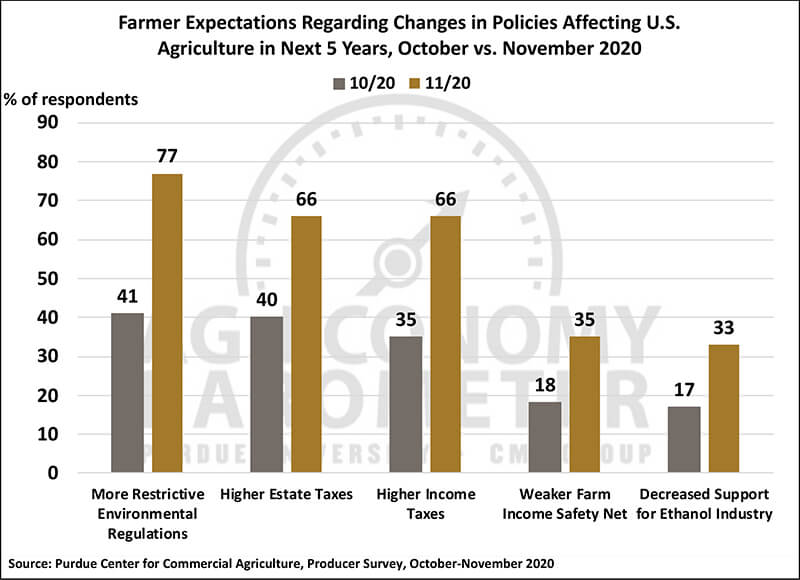Farmer sentiment pulls back post-election; regulation, trade, and taxes rated as top concerns
The Purdue University/CME Group Ag Economy Barometer dropped 16 points to a reading of 167 in November, down from its all-time high set just one month ago. The decrease in sentiment was led by farmers’ more pessimistic view toward the future of the agricultural economy, with the Index of Future Expectations falling 30 points to a reading of 156 in November. The ongoing rally in commodity prices and CFAP-2 payments continued to support producers’ view of current economic conditions, as the Index of Current Conditions rose 9 points in November to 187, an all-time high for the index.
The Ag Economy Barometer is calculated each month from 400 U.S. agricultural producers’ responses in a telephone survey. This month’s survey was conducted Nov. 9-13, after the U.S. election.
“Producers were more pessimistic about future economic conditions on their farms in November than they were just a month earlier,” said James Mintert, the barometer’s principal investigator and director of Purdue University’s Center for Commercial Agriculture. “This is the opposite of what happened following the November 2016 election. That year producers became much more optimistic about the future following the election and, in turn, that optimism about the future helped drive the Ag Economy Barometer up sharply in late 2016 and early 2017.”
To learn more about what factors might be motivating the shift in producers’ sentiment pre- and post-November election, a series of questions focused on producers’ expectations for environmental regulations, taxes and other key aspects of the agricultural economy, were included in both the October and November surveys. Comparing results from October to November, far more producers in November said they expect to see: 1) environmental regulations impacting agriculture to tighten over the next five years; 2) higher income tax rates for farms and ranches; 3) higher estate tax rates for farms and ranches; 4) less government support for the U.S. ethanol industry; and 5) a weaker farm income safety net provided by U.S. government program policies. For a complete breakdown of the results, view the full November Ag Economy Barometer report.
Since the summer of 2019, Purdue researchers have been tracing producers’ perceptions regarding the ongoing trade dispute between the U.S. and China – specifically, whether they think the dispute will be resolved soon and whether the outcome will ultimately benefit U.S. agriculture. In January and February 2020, 80% of survey respondents said they expected to see the trade dispute with China be resolved in a way that benefits U.S. agriculture. However, on the November survey, the percentage of farmers expecting a favorable outcome for U.S. agriculture declined to 50%, the lowest percentage recorded since the question was first included on a barometer survey. In a related question, only 44% of respondents to the November survey said they think it’s likely that China will fulfill the Phase One Trade Agreement requirements, down from 59% a month earlier.
This month’s report also asked farmers about their intentions of making large investments in their farming operations and their expectations for farmland values in the next 12 months and five years. The site also offers additional resources – such as past reports, charts and survey methodology – and a form to sign up for monthly barometer email updates and webinars.
Each month, the Purdue Center for Commercial Agriculture provides a short video analysis of the barometer results, and for even more information, check out the Purdue Commercial AgCast podcast. It includes a detailed breakdown of each month’s barometer, in addition to a discussion of recent agricultural news that impacts farmers. Available now at https://purdue.ag/agcast.
The Ag Economy Barometer, Index of Current Conditions and Index of Future Expectations are available on the Bloomberg Terminal under the following ticker symbols: AGECBARO, AGECCURC and AGECFTEX.
About the Purdue University Center for Commercial Agriculture
The Center for Commercial Agriculture was founded in 2011 to provide professional development and educational programs for farmers. Housed within Purdue University’s Department of Agricultural Economics, the center’s faculty and staff develop and execute research and educational programs that address the different needs of managing in today’s business environment.
About CME Group
As the world’s leading and most diverse derivatives marketplace, CME Group (www.cmegroup.com) enables clients to trade futures, options, cash and OTC markets, optimize portfolios, and analyze data – empowering market participants worldwide to efficiently manage risk and capture opportunities. CME Group exchanges offer the widest range of global benchmark products across all major asset classes based on interest rates, equity indexes, foreign exchange, energy, agricultural products and metals. The company offers futures and options on futures trading through the CME Globex® platform, fixed income trading via BrokerTec and foreign exchange trading on the EBS platform. In addition, it operates one of the world’s leading central counterparty clearing providers, CME Clearing. With a range of pre- and post-trade products and services underpinning the entire lifecycle of a trade, CME Group also offers optimization and reconciliation services through TriOptima, and trade processing services through Traiana.
CME Group, the Globe logo, CME, Chicago Mercantile Exchange, Globex, and E-mini are trademarks of Chicago Mercantile Exchange Inc. CBOT and Chicago Board of Trade are trademarks of Board of Trade of the City of Chicago, Inc. NYMEX, New York Mercantile Exchange and ClearPort are trademarks of New York Mercantile Exchange, Inc. COMEX is a trademark of Commodity Exchange, Inc. BrokerTec, EBS, TriOptima, and Traiana are trademarks of BrokerTec Europe LTD, EBS Group LTD, TriOptima AB, and Traiana, Inc., respectively. Dow Jones, Dow Jones Industrial Average, S&P 500, and S&P are service and/or trademarks of Dow Jones Trademark Holdings LLC, Standard & Poor’s Financial Services LLC and S&P/Dow Jones Indices LLC, as the case may be, and have been licensed for use by Chicago Mercantile Exchange Inc. All other trademarks are the property of their respective owners.








